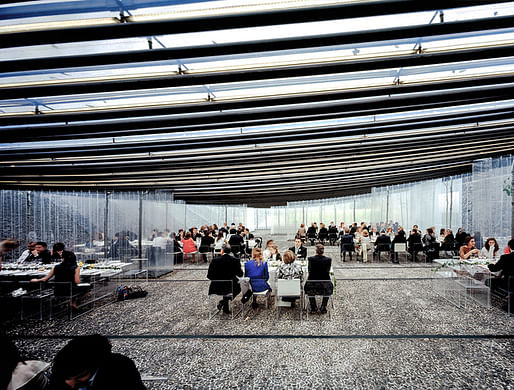
Rafael Aranda, Carme Pigem and Ramon Vilalta, all three co-founders of RCR Arquitectes, have been named the laureates of the 2017 Pritzker Prize. Dubbed as the "Nobel Prize" of architecture, the illustrious Pritzker isn't only a big deal in terms of prestige. Once the latest laureate is revealed, the debate surrounding the prize is ignited once more — from questioning the prize's significance in the field to discussing which architect should have won.
It's the first time that three architects have been honored with the prize. Originally from Olot in the Catalonian region of Spain, Aranda, Pigem, and Vilalta have worked closely together since founding RCR Arquitectes in 1988. It was this nearly three-decade collaboration — along with their longtime commitment to creative vision and equal sharing of responsibilities — that led the jury to select all three architects to win.
Emphasizing place, narrative, and materiality in their work, their projects “seek connections between the exterior and interior, resulting in emotional and experiential architecture”. Here are some of their notable projects, many of which can be found throughout Catalonia, Spain, and greater Europe:

↑ Bell–Lloc Winery, 2007, Palamós, Girona, Spain. Photo: Hisao Suzuki.

↑ Soulages Museum, 2014, Rodez, France. In collaboration with G. Trégouët. Photo: Hisao Suzuki.

↑ La Lira Theater Public Open Space, 2011, Ripoll, Girona, Spain. In collaboration with J. Puigcorbé. Photo: Hisao Suzuki.

↑ El Petit Comte Kindergarten, 2010, Besalú, Girona, Spain. In collaboration with J. Puigcorbé. Photo: Hisao Suzuki.

↑ Les Cols Restaurant Marquee, 2011, Olot, Girona, Spain. Photo: Hisao Suzuki.

↑ Barberí Laboratory, 2008, Olot, Girona, Spain. Photo: Hisao Suzuki.

↑ Sant Antoni – Joan Oliver Library, Senior Citizens Center and Cándida Pérez Gardens, 2007, Barcelona, Spain. Photo: Hisao Suzuki.

↑ Tossols-Basil Athletics Track, 2000, Olot, Girona, Spain. Photo: Hisao Suzuki.

↑ La Cuisine Art Center, 2014,a Nègrepelisse, France. Photo: Hisao Suzuki.

↑ Row House, 2012, Olot, Girona, Spain. Photo: Hisao Suzuki.
“They’ve demonstrated that unity of a material can lend such incredible strength and simplicity to a building,” Jury Chair Glenn Murcutt said in a statement. “The collaboration of these three architects produces uncompromising architecture of a poetic level, representing timeless work that reflects great respect for the past, while projecting clarity that is of the present and the future.”
Pritzker laureates receive a US$100,000 prize, a formal citation certificate, and a bronze medallion inspired by the designs of iconic architect Louis Sullivan. The winners will be presented with the award during a formal ceremony at the State Guest House, Akasaka Palace in Tokyo on May 20.
Over the last decade, previous laureates include Alejandro Aravena (2016), the late Frei Otto (2015), Shigeru Ban (2014), Toyo Ito (2013), Wang Shu (2012), Eduardo Souto de Moura (2011), SANAA (2010), Peter Zumthor (2009), and Paulo Mendes da Rocha (2006).
21 Comments
ohmygod the psychic was RIGHT
I congratulate them. I supported S. Calatrava. Among the nominees were S. Calatrava and D. Libeskind.
What do you mean by the nominees were Calatrava and Libeskind, do you have a link for that?
http://www.archdaily.com/801407/who-should-win-the-2017-pritzker-prize
Ha ha, that's a google doc form by archdaily, I surely hope the jury didn't consult that list because the winners aren't even on it ;-)
Great choice. Fantastic work. By sticking to its program. Pritzker seems like a needed critique of an ignorant design media.
Great news!
Never heard of them. Don't care.
Whew, excellent endorsement!
"I have no curiosity about the world."
What do you expect from Smails, he puts ketchup on strip steak, well done strip steak.
As long as they are not Corporate, not American, do not design for the rich, Barf-ton doesn't care. But he has no problem working for oil rich countries to line his pockets.
honest fan
then don't lift the rock.
Enhorabuena!!!.....mas que merecido e resultado de un trabajo de muchos años!!!!
And Steven Holl didn't...
Its impressive that they were able to achieve these large and luxuriously rusty and crusty buildings. I don't find them particularly interesting or inspiring.
Pritzker is afraid of losing objectivity, awarding bonuses only known architects ...
how can you award "bonuses" to somebody you don't know?
I agree davvid. I guess in the current architectural culture they seem above reproach, what with the honest materials, minimalism, etc. Maybe a reaction to the overt sculpturalism of recent starchitecture.
Beautiful work. Especially that Barberi laboratory.
Block this user
Are you sure you want to block this user and hide all related comments throughout the site?
Archinect
This is your first comment on Archinect. Your comment will be visible once approved.